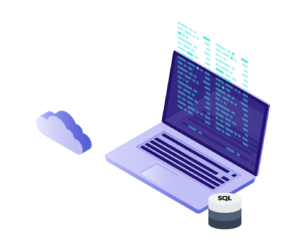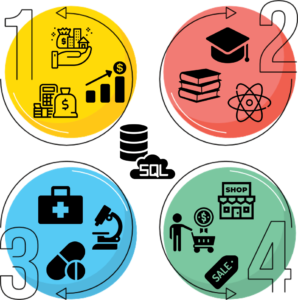SQL Essentials Training
- 12k Enrolled Learners
- Weekend/Weekday
- Self Paced
In our day to day life, we use numerous applications, gadgets and devices. An enormous amount of data is being generated every second. SQL provides a standard way to tackle this kind of data. Through the medium of this article ill explain you the concepts of what is SQL and its evolution.
Since the very beginning of the computing era, data storage was already became one of the major concerns. Previously, we used to store the data in a file-based system and this lead to mismanagement of the data. Even though it seemed to be neatly organized it had its own internal flaws. Below I have listed a few of them:
 It exists when the same data are stored in different places in our computer system. In File System, there is no active check for the duplicate files. This will increase the structure size and also leads to a lack of security features. Because of this, the file system is highly vulnerable in nature.
It exists when the same data are stored in different places in our computer system. In File System, there is no active check for the duplicate files. This will increase the structure size and also leads to a lack of security features. Because of this, the file system is highly vulnerable in nature.
Data sharing and security are closely related. Sharing data among multiple geographically spread users introduces a lot of security risks. In terms of spreadsheet data and other documents, the inbuilt file system programs provide basic security options, but they are not always used.
In terms of the creation of data management and reporting programs, security and data-sharing features are usually 
 Another important problem in traditional file environment system is the difficulty of getting quick answers because it needs more Adhoc queries and more programming for new reports. So, we can’t make the decision very fast.
Another important problem in traditional file environment system is the difficulty of getting quick answers because it needs more Adhoc queries and more programming for new reports. So, we can’t make the decision very fast.
 In File System, files and records are described by a specific physical format that is coded into the application by programmers. If the format of anyone record was changed, then we need to make sure that all the remaining records format is updated. This information has to be updated in the system also. Any changes in storage structure or access methods could greatly affect the processing or results of an application.
In File System, files and records are described by a specific physical format that is coded into the application by programmers. If the format of anyone record was changed, then we need to make sure that all the remaining records format is updated. This information has to be updated in the system also. Any changes in storage structure or access methods could greatly affect the processing or results of an application.
Because of all the above-mentioned drawbacks and as well as few other limitations, there was a need for implementing a new technique, so the SQL was born.
SQL was developed in the 1970s at IBM Corporation, Inc., by Donald Chamberlin and Raymond F Boyce. It was initially called SEQUEL but was later changed to SQL. The reason for this change of name is SEQUEL was the name of the UK based Engineering company. In SQL the data is stored in the form of relations. This relation theory was suggested by Boyce and Chamberlin.
Only after certain years, SQL language was made publicly available. The first company to release an altered version of SQL was Relational Software, Inc. (now Oracle) and it called it as Oracle V2. After that American National Standards Institute (ANSI) and the International Standards Organization have deemed the SQL language the standard language in relational database communication. Today, SQL is accepted as the standard language for Relational Database Management System.
Structured Query language (SQL) is pronounced as “S-Q-L” or sometimes as “See-Quel” which is the standard language for dealing with Relational Databases. Let us take more of a real-life example to understand what exactly SQL is.
If two persons want to communicate with each other then they have to use certain language which is understood by both of them. If we consider these two people, one as a user and the other as a database, then that language which is used for communication between these two is called SQL. Similarly, how a language has the grammar and various rules on how it should be used, even SQL has its own directives.
Learn more about SQL Server and its framework from the SQL Online Course.
SQL is effectively used to insert, search, update, delete, modify database records. It doesn’t mean SQL cannot do things beyond that. In fact, it can do a lot more other things as well.
Now that we have understood what is SQL, let us look at its processing capabilities:
Let us look at some Basic Queries that are most popular in SQL.
Create Database database_name;
Drop Database database_name;
Create Table table_name;
Drop Table table_name;
So if you want to learn more SQL queries then have a look at the article on SQL Basics which I have written. This article will help you to get started with the SQL
Since we have understood what SQL is all about, now its time to know its advantages.
As it says, Developers of SQL has mentioned how exactly each and every query has to be written. There is no room for ambiguity when it comes to writing a query. The standards have to be followed.
Yes, SQL is a language that is used to work with the database. Since SQL has a large user base as well as a well-defined standard, for a beginner it is really easy to learn.
This is one of the unique and early features that SQL came up with. View is nothing but creating a virtual table. A virtual table is a temporary table for certain use. By doing this we can protect the integrity of the data. SQL cannot only create a single view but can create multiple views.
It means we can execute the SQL queries in one system and execute the same in another system, without changing the format. But the condition is that the environment setup of these systems has to be the same. Else the query won’t be executed
The main purpose of SQL is to communicate with the database. We can write complex queries to fetch the results from the database and these queries can be easily understood by anyone.
Now, lets now see some of its real-time application.
Since SQL is a language that is used to operate on the database, we need to look at the bigger picture of the data management industry. Here if I say Database, it includes SQL language as well. The database is used in different verticals like Online stores, health care providers, clubs, libraries, video stores, beauty salons, travel agencies, phone companies, government agencies, etc. Now let’s consider some real-time examples for the use of SQL and Database.

Managing money, assets, shares etc in a real-time is a tedious task. SQL and Database technology is helping the financial sector to achieve its primary task. SQL queries can be also used to check the fraudulent activities.
Database systems are frequently used in schools, colleges and in universities to store and retrieve the data regarding student details, staff details, course details, exam details, payroll data, attendance details, fees details, etc. There is a lot amount of inter-related data that needs to be stored and retrieved efficiently.
In hospitals and medical institution maintaining data related to doctors, patients and staff is a huge task. Effectively coordinating among these three has to be handled seamlessly. With the help of SQL and Database, this industry has gained a lot.
In retail industry customers data has to be managed effectively. There is no scope for error when it comes to handling the data. With the instigation of SQL and Database system, the retail industry can not only secure the data but also can get the real-time analysis.
This brings us to the end of this What is SQL article. I hope you understood the Evolution of SQL in depth.
For details, You can even check out how to manage databases on SQL Server and its concepts with the SQL certification course.
If you wish to learn more about MySQL and get to know this open-source relational database, then check out our MySQL DBA Certification Training which comes with instructor-led live training and real-life project experience. This training will help you understand MySQL in-depth and help you achieve mastery over the subject.
 Thank you for registering Join Edureka Meetup community for 100+ Free Webinars each month JOIN MEETUP GROUP
Thank you for registering Join Edureka Meetup community for 100+ Free Webinars each month JOIN MEETUP GROUPedureka.co